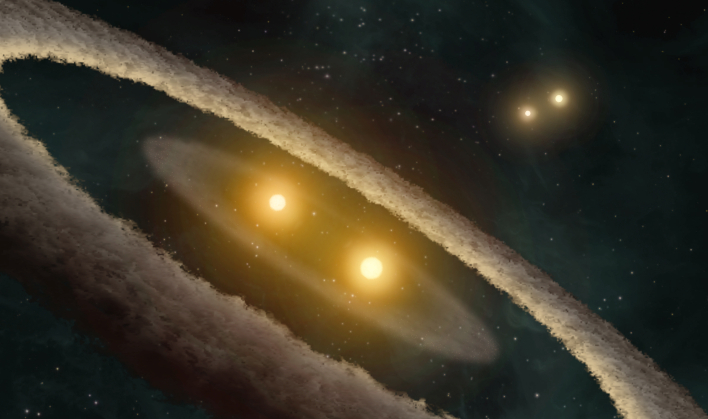Astronomers Discover Mysterious Triple Sun Formation With A Dark Secret
With the James Webb Space Telescope beginning to share new images of deep space, it is easy to forget that there are many other discoveries being made about our universe without the aid of the iconic space telescope. Two young researchers at the Niels Bohr Institute at the University of Copenhagen have taken on the task of trying to figure out how a unique combination of a binary set of stars and a revolving larger star came to be.
The star system that is being studied consists of two stars that orbit one another, with a colossal sized star orbiting the binary. It is believed that the mass of the binary stars is twelve times the mass of our Sun. The binary has an orbital period similar to that of the rotation of Earth (1 day). The inner orbit takes on a circular shape, with close to six revolutions of the tertiary star around the binary per year.
"As far as we know, it is the first of its kind ever detected," remarked Alejandro Vigna-Gomez. "We know of many tertiary star systems (three star systems), but they are typically significantly less massive. The massive stars in this triple are very close together - it is a compact system."

The actual discovery of the star system was made by a community of amateur astronomers, who were sifting through a public data set from NASA's Transiting Exoplanet Survey Satellite (TESS) observatory. The group of amateurs brought the anomalies they had found to the attention of professional astronomers, revealing what had been thought to be two stars, were actually three.
The young duo of researchers used their combined expertise to code the options of how this triple star system came to be, and then ran more than 100,000 iterations on a computer. The result was that the most likely scenario involved two binary systems forming initially, with one of the binary systems merging into one at some point. See the image above for an example of two binary star systems, which the researchers believe was the case for the current star system before one set of stars eventually merged into a singular one.
"Now we have a model of the most likely scenario of this unique system. But a model is not enough," explained Vigna-Gomez. He continued by saying that there are now two ways in which they can prove their theory on the formation. "One is studying the system in detail and the other is to make a statistical analysis on a population of stars."
Bin Liu, the second member of the duo, encourages people in the public to take a deep look into the data as well. He added, "Maybe there are more compact systems buried in the data. What we want to know is whether this kind of system is common in our universe."
You can view the researchers work thus far in a publicly available scientific article.
Top Image Credit: JPL/NASA

